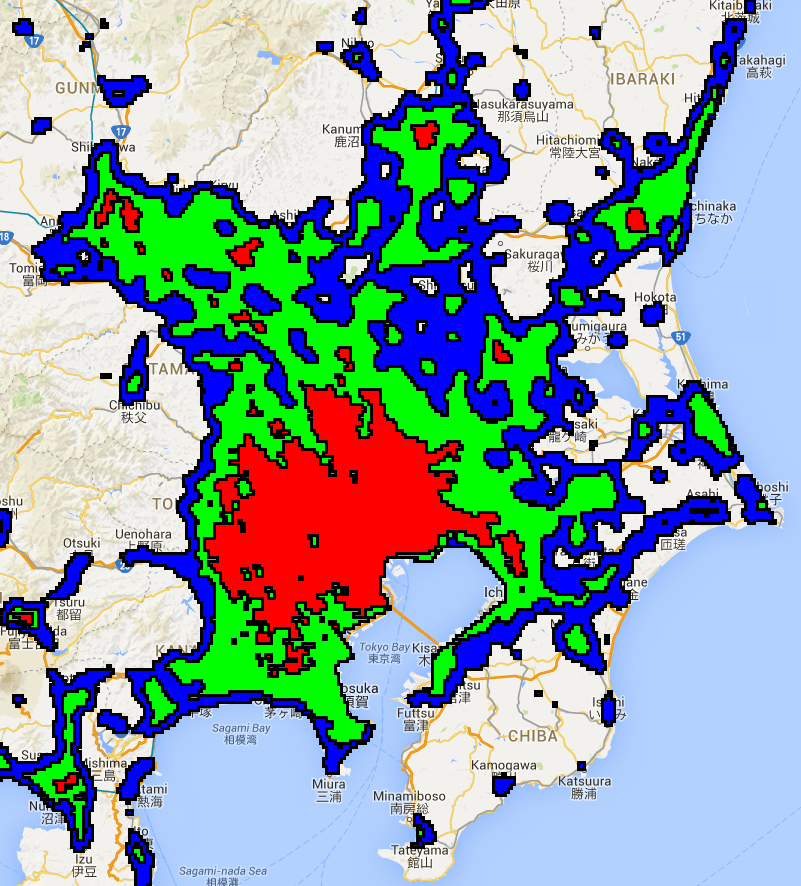如要將 Image (光柵) 轉換為 FeatureCollection (向量) 資料類型,請使用 image.reduceToVectors()。這是 Earth Engine 中向量化的首要機制,可用於產生區域,以便輸入其他類型的減算器。reduceToVectors() 方法會在連接像素的單一群組邊界上建立多邊形邊緣 (可選取的圓心或邊界框架)。
舉例來說,我們來看看 2012 年日本的夜光圖像。讓夜燈的數位編號做為開發強度的代理值。使用夜燈的任意門檻定義區域,將區域合併為單一頻帶圖像,然後使用 reduceToVectors() 將區域向量化:
程式碼編輯器 (JavaScript)
// Load a Japan boundary from the Large Scale International Boundary dataset. var japan = ee.FeatureCollection('USDOS/LSIB_SIMPLE/2017') .filter(ee.Filter.eq('country_na', 'Japan')); // Load a 2012 nightlights image, clipped to the Japan border. var nl2012 = ee.Image('NOAA/DMSP-OLS/NIGHTTIME_LIGHTS/F182012') .select('stable_lights') .clipToCollection(japan); // Define arbitrary thresholds on the 6-bit nightlights image. var zones = nl2012.gt(30).add(nl2012.gt(55)).add(nl2012.gt(62)); zones = zones.updateMask(zones.neq(0)); // Convert the zones of the thresholded nightlights to vectors. var vectors = zones.addBands(nl2012).reduceToVectors({ geometry: japan, crs: nl2012.projection(), scale: 1000, geometryType: 'polygon', eightConnected: false, labelProperty: 'zone', reducer: ee.Reducer.mean() }); // Display the thresholds. Map.setCenter(139.6225, 35.712, 9); Map.addLayer(zones, {min: 1, max: 3, palette: ['0000FF', '00FF00', 'FF0000']}, 'raster'); // Make a display image for the vectors, add it to the map. var display = ee.Image(0).updateMask(0).paint(vectors, '000000', 3); Map.addLayer(display, {palette: '000000'}, 'vectors');
import ee import geemap.core as geemap
Colab (Python)
# Load a Japan boundary from the Large Scale International Boundary dataset. japan = ee.FeatureCollection('USDOS/LSIB_SIMPLE/2017').filter( ee.Filter.eq('country_na', 'Japan') ) # Load a 2012 nightlights image, clipped to the Japan border. nl_2012 = ( ee.Image('NOAA/DMSP-OLS/NIGHTTIME_LIGHTS/F182012') .select('stable_lights') .clipToCollection(japan) ) # Define arbitrary thresholds on the 6-bit nightlights image. zones = nl_2012.gt(30).add(nl_2012.gt(55)).add(nl_2012.gt(62)) zones = zones.updateMask(zones.neq(0)) # Convert the zones of the thresholded nightlights to vectors. vectors = zones.addBands(nl_2012).reduceToVectors( geometry=japan, crs=nl_2012.projection(), scale=1000, geometryType='polygon', eightConnected=False, labelProperty='zone', reducer=ee.Reducer.mean(), ) # Display the thresholds. m = geemap.Map() m.set_center(139.6225, 35.712, 9) m.add_layer( zones, {'min': 1, 'max': 3, 'palette': ['0000FF', '00FF00', 'FF0000']}, 'raster', ) # Make a display image for the vectors, add it to the map. display_image = ee.Image(0).updateMask(0).paint(vectors, '000000', 3) m.add_layer(display_image, {'palette': '000000'}, 'vectors') m
請注意,輸入內容中的第一個頻帶用於識別同質區域,而剩餘的頻帶則會根據提供的縮減器進行縮減,其輸出內容會新增為結果向量屬性。geometry 參數會指定應在哪個範圍內建立向量。一般來說,建議您指定最小可用區,以便建立向量。建議您指定 scale 和 crs,以免造成混淆。輸出類型為 ‘polygon’,其中多邊形是由四個相連相鄰區域的同質區域所形成 (即 eightConnected 為 false)。最後兩個參數 labelProperty 和 reducer 分別指定輸出多邊形應分別接收區域標籤和夜燈頻帶的平均值。
繪製結果應類似圖 1 所示的東京地區。檢查輸出多邊形後,我們發現每個多邊形都有一個屬性,用於儲存區域的標籤 ({1, 2, 3}) 和夜燈頻帶的平均值,因為我們已指定平均值縮減器。

